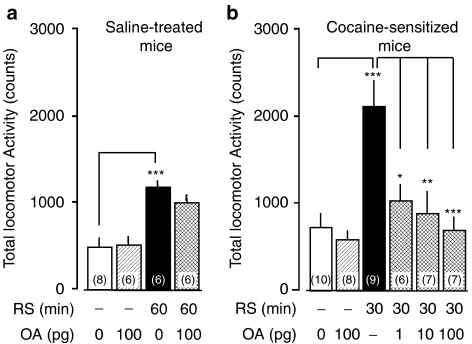Figure 6.
Restraint stress (RS) elicits OA-sensitive hyperlocomotion in cocaine-sensitized mice. Forty animals were given the cocaine regimen followed by locomotor testing as described earlier, but three animals did not develop behavioral sensitization and thus were omitted from the data. Three omitted animals were used in experiments described in Figure 5 as nonsensitized animals. The remaining 37 mice with behavioral sensitization were assigned randomly as shown by the number in the parenthesis in the treatment groups. Intracerebroventricular administration of OA or saline was given to saline-treated (a) and cocaine-sensitized (b) mice immediately before restraint on day 7 of withdrawal, and subsequent locomotor activity was monitored for 60 min. A one-way ANOVA followed by Bonferroni test revealed a significant increase in locomotor activity induced by 60 min-RS (F(3,22)=11.40, P=1.03 × 10−4; t=5.06, P<0.001) which was not altered in saline-treated mice by 100 pg OA immediately before RS (t=1.25, P>0.05). On the other hand, OA (1–100 pg) suppressed the significant increase in locomotor activity induced by 30 min-RS in cocaine-sensitized mice (F(5,41)=8.23, P=1.88 × 10−5; t=5.17, P<0.001) in a dose-dependent manner (t=3.52, P<0.05 at 1 pg; t=4.17, P<0.01 at 10 pg; t=4.84, P<0.001 at 100 pg, vs 30-min RS without OA in cocaine-sensitized mice). *P<0.05, **P<0.01 and ***P<0.001 determined by Bonferroni test.

